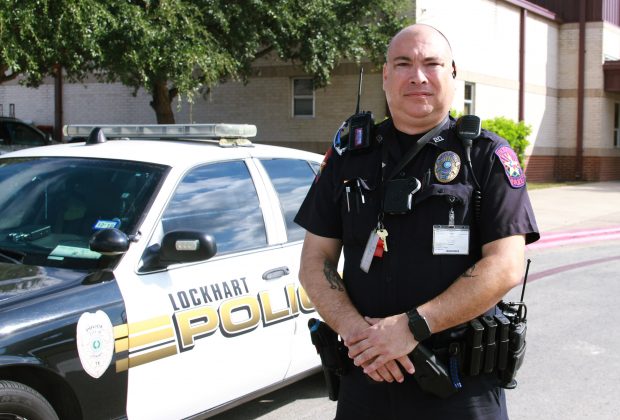Lockhart police officers provide safety, educational resource to students
For two decades, the Lockhart Independent School District and the Lockhart Police Department have shared the task of keeping campuses safe through the school resource officer program.
A school resource officer is often described as a career law enforcement officer with sworn authority who is deployed by a police department in a community-oriented policing assignment to work in collaboration with one or more schools.
Lockhart Independent School District shares a memorandum of understanding with the City of Lockhart that compensates the city for utilizing its police resources. The specially trained officers work closely with administrators to create a safer environment for both students and staff.
For two years, school resource officers have been placed at the Lockhart Junior High School Campus, where Officer Chad Corbitt patrols the grounds, and Lockhart High School, where Officer Stephen Parra is stationed and provides a daily presence.
The officers, who take part in an enhanced training program before they are assigned their roles, perform a number of duties. They have the ability to respond to calls at any of Lockhart’s campuses and document incidents that have occurred, but go above and beyond merely enforcing the law, said LISD Deputy Superintendent Kimberly Brents.
Lockhart Police are on campus to help students, acting as trusty confidants who provide a receptive ear to students in need.
“Our officers also act as mentors and make presentations to the student body on topics that are relevant to societal demands,” Brents explained.
While helping keep those campuses secure is part of their objective, they are not there to arrest your kids for breaking school rules.
“The law is very clear,” said Lt. Chris Knudsen of the Lockhart Police Department, who has been a longtime coordinator of the school resource officer program. “Unless a criminal offense has occurred, school resource officers do not get involved. We cannot enforce school rules and policies.”
Prior to recent legislation, school resource officers could and did issue citations for Class C misdemeanors like fighting, which also violates conduct codes in most schools.
“Now, the school district is required to file charges before the legal system can get involved,” Knudsen explained.
So what’s a typical day look like for a school resource officer?
Knudsen, who was once an SRO himself before heading Lockhart’s program, said the officers walk conspicuously among the students. They show up at school in the morning and greet students as they enter the campuses.
“Of course, we’re dealing with junior high kids and high school kids, so some of the greetings are less enthusiastic than you’d hope for,” Knudsen chuckled. “But they’re very visible in the morning.”
After the bell rings, officers continue to walk the halls and walk the ground outside. They may keep an eye out for bags that have been left behind by students while on general safety patrol. They monitor the lunchrooms and also assist with dismissal at the end of the day, even helping with school bus traffic.
“Besides hanging out, they might also prepare for class if they’re scheduled to make a presentation,” Knudsen said.
Additionally, they’re present at home football games. Five officers work the games: both SROs and three additional on-duty patrol officers.
“We like doing that,” Knudsen noted.
School resource officers are also part of the LISD safety task force, which was created in spring 2018 following the Parkland, Florida school shooting, Brents said.
“It involves local law enforcement – city, county and state, as well as fire and emergency services,” she explained. “We realized that there should be an event such as this, we would all be in it together to respond, and so we wanted to make sure we were all working together seamlessly beforehand.
“Since the time of our first meeting, we have responded to issues such as the Austin bombings and the Santa Fe school shooting.
“This allows us to review current practices and make changes at the school level with expertise from this task force. As well, the task force assists us in our monthly drills of both fire and lockdown. Resource officers receive information about what is discussed at these meetings from Lt. Knudsen.”
Lt. Knudsen says the educational and mentoring aspects of the program are all about building better citizens, which is very satisfying for the officers.
“We really enjoy working with and being there for the students and we always have,” Knudsen said.
By the numbers
– The state’s Mental Health First Aid program experienced a 37% increase in the number of public school district employees and school resource officers trained in Fiscal Year 2018 compared to FY 2017, and over 10,000 school personnel were trained in FY 2019
– The Texas Department of Public Safety is working with the Texas Education Agency and the Texas Higher Education Coordinating Board on ways to better inform schools, students, staff and families about the importance of reports on suspicious activity and how to initiate that process.
– Senate Bill 11 provides districts with $100 million in funding for school based mental health centers, the hiring of counselors, and other mental health needs, and provides $99 million in funding for the Texas Mental Health Care Consortium.
– The Texas Education Agency has been awarded $2 million in federal grants for schools to implement threat assessment and mental health training programs.




